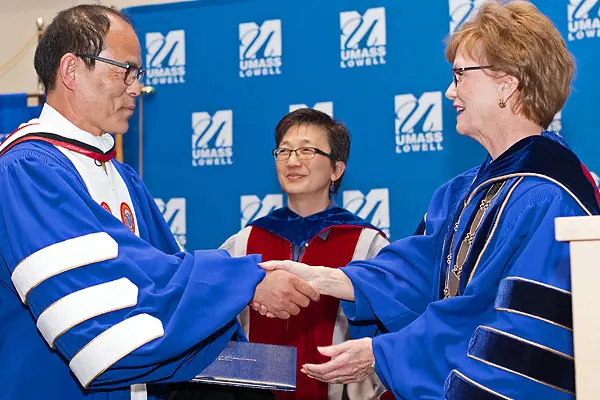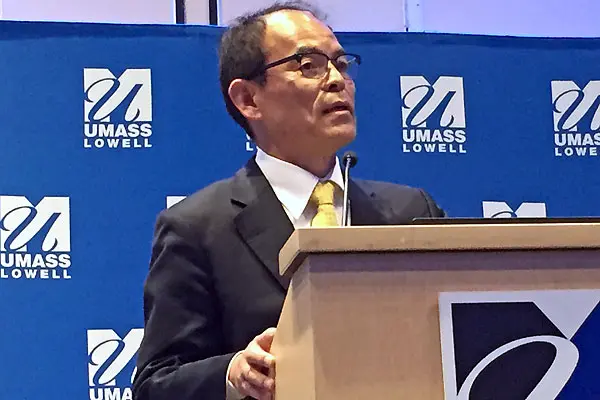Inventor of Blue LED Delivers the University’s Tripathy Memorial Lecture
 Image by Tory Germann for UML
Image by Tory Germann for UML
04/20/2018
By Edwin Aguirre
Advances in lighting technology are improving the quality and safety of everything – from cars to computer screens and cell-phones – and some day may make ubiquitous Wi-Fi networks obsolete.
That’s the message Nobel laureate Shuji Nakamura, a researcher at the University of California, Santa Barbara, delivered to a packed audience recently at University Crossing.
“Laser diodes are the light of the future,” said Nakamura, who was on campus to deliver this year’s Tripathy Endowed Memorial Lecture and receive an honorary doctorate. More than 100 students, faculty and staff were on hand for the event.
Each year, a leading scientist and scholar comes to UMass Lowell to present the lecture in memory of Sukant K. Tripathy, the late professor of chemistry who was internationally recognized for his research in the area of thin polymer films in electronics and optics. He founded the university’s Center for Advanced Materials and served as provost and vice chancellor for academic affairs.
In awarding Nakamura an honorary doctor of humane letters degree, Chancellor Jacquie Moloney cited his “significant, ongoing and innovative contributions to solving the world’s energy challenges.”
Let There Be Violet Light
Used in residential and commercial lighting, electronics, automobiles and many household products, light-emitting diodes (LEDs) give off bright white light that saves energy by producing light approximately four times more efficiently than fluorescent lights and 20 times more efficiently than incandescent bulbs.
But white LED light requires a combination of red, green and blue lights, and blue LEDs are much more challenging to fabricate than red and green diodes. Nakamura was awarded a share of the 2014 Nobel Prize in physics for successfully using the difficult-to-handle gallium nitride (GaN) semiconductor material to invent efficient blue LEDs, which made bright white light sources possible.
Nakamura said the innovative “GaN-on-GaN” full-visible-spectrum violet LED technology that he co-developed, which matches the characteristics of natural sunlight, is the healthiest lighting solution for people because it mimics the natural dawn-to-dusk light cycle and does not disrupt a person’s circadian rhythm.
Violet light also suppresses the progression of myopia (nearsightedness) by reducing eyestrain in people who use computer monitors, cell phones and tablets extensively, he said.
GaN-on-GaN lighting products for the home, office or retail space are currently marketed through Soraa, a company that Nakamura founded in 2008.
Looking into the Future

Nakamura discussed the development of high-efficiency blue indium gallium nitride LEDs and laser diodes during his Tripathy Endowed Memorial Lecture on April 11.
For example, automakers Audi and BMW are already using laser headlights in some of their new car models. Laser headlights are about four times brighter and can illuminate twice the distance of current standard LED headlights without compromising road safety. They use smart technology that can actively steer the light away from incoming traffic.
“This way, this highest of all high beams can’t blind other drivers,” Nakamura said.
The Next Generation of High-speed Wireless Communication: Li-Fi with LEDs
Light Fidelity, or Li-Fi for short, holds the promise of revolutionizing how we communicate, stay connected and share data. Unlike Wi-Fi, which uses radio waves to transmit data, Li-Fi works through visible light. It uses common household LED light bulbs to transfer vast amounts of information at very high speeds.
“Research has already shown that Li-Fi has the potential to be at least 100 times faster than traditional Wi-Fi, as well as costing far less for homes and businesses to operate,” said Nakamura. “It is the fastest and cheapest way to wirelessly connect to the internet and will eventually give speeds of more than 100 gigabits per second; that means it would take less than 30 seconds to download a full-length HD movie.”
Nakamura joins a distinguished list of Nobel laureates and leaders in materials science research who have delivered the Tripathy lecture at UMass Lowell, including Steven Chu (co-winner, 1997 Nobel Prize in Physics), Profs. Alan MacDiarmid and Alan Heeger (co-winners, 2000 Nobel Prize in Chemistry), Wolfgang Ketterle (co-winner, 2001 Nobel Prize in Physics), Robert Grubbs (co-winner, 2005 Nobel Prize in Chemistry) and Craig Mello (co-winner, 2006 Nobel Prize in Physiology or Medicine).
